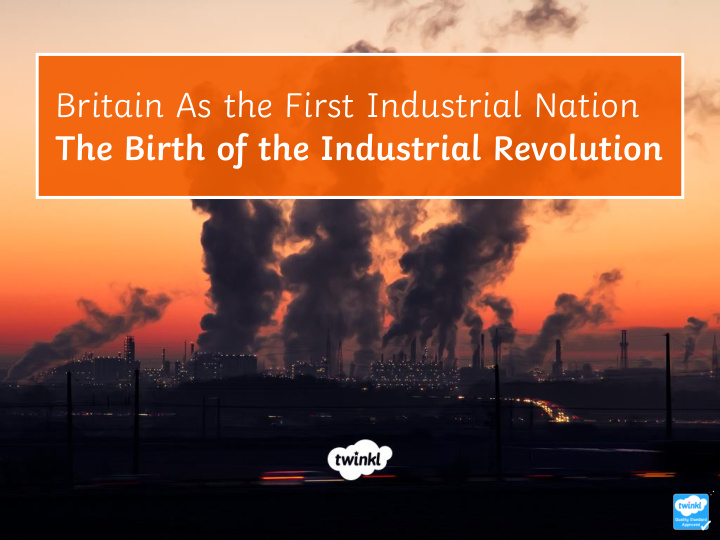



Britain As the First Industrial Nation The Birth of the Industrial Revolution
Learning Objective To understand the main factors in the creation of industrial Britain. • Success Criteria • To consider the importance of cities. • To prioritise the factors of the industrial revolution from most to least important. • To explain personal views on the most important factor.
Why Cities? The birth of modern cities was an important step in human history. Discuss why cities are important with a partner. What do cities give us that country villages could not? Can you come up with three reasons together?
What Was the Industrial Revolution? The Industrial Revolution was a time in British history where the country changed hugely from a mostly rural society to an industrial one. This means that many British people moved from living in small towns and villages, where they were farmers, to huge cities, where they worked in places such as factories or mills. It is called a revolution because it was such a huge change. The birth of the Industrial Revolution is the birth of the modern world that we know today. Key Terms rural - life in the countryside. industrial – life in cities centred around mass production.
Six Factors There were six main factors that came together to create the Industrial Revolution. Unlike political or violent revolutions, the Industrial Revolution happened over a long period of time rather than suddenly. Just like baking a cake, the ingredients for the Industrial Revolution had to be present together at the right time and then left to heat up… In your groups, read through your information sheet and create a freezeframe – an still group image that will sum up the information you have been given. Be ready to share with the class!
Population Boom Between 1750 and 1900, the population of Britain grew by four times, from 10 million people to 40 million people. This created problems: How could this population be fed, clothed and housed? Supply was found to match demand. This increase in population led to many businessmen and innovators finding ingenious solutions whilst making a lot of money. 3.0 billion 6.0 billion 9.0 billion 1960 2000 2050
Improved Agriculture During this period, farmers became more efficient in order to feed the growing population. Using advances such as improved crop rotation, selective breeding of animals and new machinery, farmers made the land that had been farmed in a similar way for centuries more efficient. One of the most important early developments was Jethro Tull’s seed drill. The seed drill planted seeds quickly and efficiently without the need to do it by hand.
Factories It was not only farmers who were developing new machines and ideas. Factories began to be built in cities to produce goods at a far faster rate than before. People moved from the countryside to the cities to work in them. Woollen cloth and cotton goods had been produced in small amounts in people’s homes for centuries. A factory could produce huge amounts textiles quickly: useful for clothing the increasing population and as trade goods.
Power The first factories were powered by water and used wooden machines. New types of power would lead to bigger, more efficient factories. Coal was mined in large amounts and used to create wrought-iron: iron that was tough enough to create large, complex machines. Steam power was a technology that led to innovations such as James Nasmyth’s steam hammer, as well as new forms of transport.
Transport With growth in agriculture and industry, things needed to be moved around the country in large amounts. Canals, such as the Bridgewater Canal, were dug to link growing cities together - in this case, Manchester and Liverpool - and transport goods between them. Roads were improved to make travel by cart easier and faster. Railways were laid to accommodate a new, wondrous invention: the steam train.
Empire It was not just at home that Britain grew. The British Empire expanded from a few colonies in 1750 to cover a fifth of the world’s land by 1900. Colonies in places such as India, Australia, Canada and South Africa gave British factories access to exotic resources such as cotton, silk, fur and tea. By 1900, the Empire had a population of around 400 million people; each of these a potential customer for British goods, which pushed production ever onwards.
The Perfect Recipe When all mixed together, the six factors we have looked at created the Industrial Revolution. Now you have had a chance to see the factors that went into the Industrial Revolution, fill in your activity sheets with as much information as you can.
The Workshop of the World Britain became known as the ‘workshop of the world’ by the mid -19th century. Can you explain what this means?
Recommend
More recommend